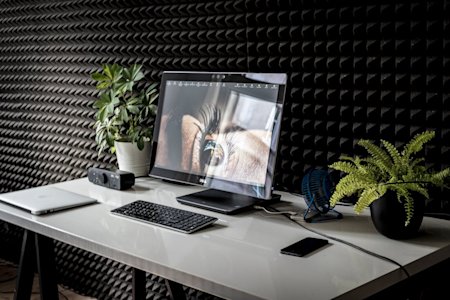Remote desktop is a technology that allows users to access and control a computer from a different location using a network connection. It enables individuals and IT teams to work remotely, provide technical support, and manage systems without needing physical access. Remote desktop solutions enhance productivity, streamline IT operations, and ensure seamless collaboration, making them essential for businesses, educators, and remote workers.
In an era where remote work and global collaboration are the new norm, the ability to access and manage computers from afar is no longer a luxury—it's a necessity. Whether it's accessing files, running applications, or providing technical support, remote desktop solutions offer unparalleled flexibility and control, making them indispensable for businesses of all sizes.
The concept of remote desktop isn't new, but its relevance has skyrocketed with the rise of remote work and the need for seamless, secure access to resources. By leveraging remote desktop technology, businesses can ensure that their teams remain productive, regardless of their physical location.
In this blog, we will explore what remote desktop technology is, how it functions, and the myriad benefits it offers to businesses.

How Does Remote Desktop Work?
Remote desktop technology enables users to connect to and control a computer from another location through a secure network connection. Here’s how it works at a technical level:
Session Initiation: The remote desktop client sends a connection request to the remote computer, typically over the internet or a private network.
Network Communication: The remote desktop protocol (e.g., Splashtop’s proprietary protocol) establishes an encrypted session between the client and the remote device.
Screen & Input Transmission: The remote computer’s display is encoded and transmitted to the client device, while user inputs (mouse movements and keyboard actions) are sent back in real time.
Data Encryption & Security Measures: Advanced encryption protocols, such as TLS and AES, secure the data transmission to prevent unauthorized access or interception.
Multi-Monitor & Peripheral Support: The remote desktop software enables features like multi-monitor display, file transfer, clipboard sharing, and peripheral device access (printers, USB devices).
By leveraging these technologies, remote desktop solutions like Splashtop provide low-latency, high-performance remote access for businesses, IT administrators, and professionals who need secure and efficient remote connectivity.
Benefits of Remote Desktop Technology for Business
Remote desktop technology has become an integral part of modern business operations, especially as remote work and distributed teams have become more common. By allowing employees and IT professionals to access computers and networks from virtually anywhere, remote desktop technology offers numerous advantages that enhance productivity, efficiency, and security within an organization.
Here’s a closer look at the key benefit of remote desktop solutions that businesses can gain.
1. Enhanced Flexibility and Mobility
One of the most significant benefits of remote desktop technology is the ability to access workstations and resources from any location with an internet connection. This flexibility is invaluable for businesses with remote or hybrid work models, as it allows employees to work from home, while traveling, or from other off-site locations without compromising their access to essential tools and data.
2. Cost Savings and Resource Optimization
Implementing remote desktop technology can lead to substantial cost savings for businesses. For instance, companies can reduce the need for physical office space and associated overhead costs by allowing employees to work remotely. Additionally, remote desktop solutions can extend the lifespan of existing hardware by enabling access to powerful, centralized resources from less expensive, less powerful client devices.
Moreover, businesses can streamline their IT operations by centralizing software and hardware management, reducing the need for on-site technical support and maintenance. This centralized approach allows IT teams to manage, update, and troubleshoot systems remotely, leading to more efficient use of resources and reducing the total cost of ownership (TCO) for IT infrastructure.
3. Increased Productivity
Remote desktop technology enables employees to access their workstations and complete tasks outside of the office, allowing for greater flexibility in managing workloads and deadlines. This increased access can lead to higher productivity levels, as employees can work in a manner that best suits their schedules and personal preferences.
4. Improved Data Security and Compliance
Data security is a top priority for businesses, and remote desktop technology can play a critical role in safeguarding sensitive information. By keeping data stored on managed computers rather than on individual devices, businesses can reduce the risk of data breaches resulting from lost or stolen hardware.
5. Scalability and Ease of Management
As businesses grow, so do their IT needs. Remote desktop technology offers a scalable solution that can easily accommodate the addition of new employees, devices, and locations without the need for significant infrastructure investments. This scalability is particularly beneficial for businesses experiencing rapid growth or those that operate in multiple regions or countries.
6. Business Continuity and Disaster Recovery
In today’s unpredictable world, having a robust business continuity plan is essential. Remote desktop technology plays a key role in disaster recovery strategies by ensuring that employees can continue to access critical systems and data even if they are unable to physically access their offices. Whether it’s a natural disaster, a cyberattack, or a pandemic, remote desktop solutions enable businesses to maintain operations with minimal disruption.
7. Support for BYOD (Bring Your Own Device) Policies
Many businesses are adopting BYOD policies to allow employees to use their personal devices for work. Remote desktop technology supports this trend by enabling secure access to corporate resources from any device, whether it’s a personal laptop, tablet, or smartphone. This not only enhances employee satisfaction by allowing them to work on their preferred devices but also reduces the need for companies to invest in expensive hardware.
Challenges of Remote Desktop
While remote desktop software enables seamless access to computers from anywhere, it comes with challenges that can impact performance, security, and usability. Understanding these challenges highlights the importance of choosing a high-quality solution.
Performance Issues – Lag, latency, and poor connection stability can disrupt workflow, especially when using low-quality or poorly optimized remote desktop software.
Security Risks – Unsecured remote access can expose systems to cyber threats, including unauthorized access, data breaches, and ransomware attacks. Open RDP ports and weak authentication are common vulnerabilities.
Compatibility Limitations – Some remote desktop solutions have restricted device or OS compatibility, limiting access across different platforms.
Complex Setup and Management – Configuring certain remote desktop tools can be complicated, requiring IT expertise and ongoing maintenance.
A premium remote desktop solution like Splashtop addresses these challenges with high-performance streaming, enterprise-grade security, broad device compatibility, and an intuitive user experience, ensuring seamless and secure remote access.
Important Features of Remote Desktop
When evaluating remote desktop solutions, it's crucial to consider the features that will meet your business's specific needs. While different solutions may offer a variety of functionalities, certain key features are essential for ensuring a secure, efficient, and user-friendly remote desktop experience.
1. High-Performance Remote Access
One of the most critical features of any remote desktop solution is its ability to provide high-performance remote access. This includes delivering a smooth, responsive experience even when accessing resource-intensive applications or high-resolution graphics.
Advanced remote desktop solutions optimize data transmission and compression to minimize latency and ensure that users experience minimal lag, even over slower connections. This high-performance capability is essential for tasks that require real-time interaction, such as video editing, graphic design, or financial trading.
2. Cross-Platform Compatibility
In today’s diverse IT landscape, businesses often rely on a mix of operating systems and devices, including Windows, macOS, Linux, Android, and iOS. A robust remote desktop solution should offer cross-platform compatibility, allowing users to connect to and control devices running different operating systems from a single interface.
3. Robust Security Features
Security is a top concern when implementing remote desktop technology, as unauthorized access to business systems can lead to data breaches, financial losses, and reputational damage. Therefore, a secure remote desktop solution should include a range of robust security features to protect against potential threats.
Key security features to look for include:
End-to-End Encryption: Ensures that all data transmitted between the client and host devices is encrypted, making it inaccessible to unauthorized parties.
Multi-Factor Authentication (MFA): Adds an extra layer of security by requiring users to verify their identity using a second factor, such as a code sent to their mobile device, in addition to their password.
Granular Access Controls: Allows administrators to define and manage access permissions, ensuring that users can only access the resources they are authorized to use.
Session Recording and Monitoring: Enables IT administrators to monitor remote sessions in real-time or review recorded sessions to detect suspicious activity and ensure compliance with security policies.
4. Scalability and Resource Management
As businesses grow, their IT needs evolve, and the ability to scale remote desktop solutions is essential. A scalable remote desktop solution should allow businesses to easily add new users, devices, and resources without the need for significant infrastructure changes.
5. User-Friendly Interface
The usability of a remote desktop solution is crucial for ensuring that employees can easily access and manage remote sessions without extensive training or technical support. A user-friendly interface should provide an intuitive experience, with easy navigation, simple setup processes, and clear instructions for connecting to remote devices.
6. File Transfer and Remote Printing
Remote desktop technology should offer seamless file transfer capabilities, allowing users to easily move files between the local and remote devices during a session. This feature is essential for tasks that require frequent sharing of documents, images, or other files between the user and the remote system.
Remote printing is another valuable feature, enabling users to print documents from the remote desktop session to a local printer or vice versa. This functionality is particularly useful for businesses that need to print invoices, reports, or other documents directly from their remote systems.
7. Customizable Access and Session Settings
Different users and business scenarios may require different access levels and session configurations. A remote desktop solution should provide customizable access settings, allowing administrators to tailor access permissions, session timeouts, display resolutions, and bandwidth usage according to the needs of the business or individual users.
9. Support for Multi-Monitor Setups
Many professionals, such as designers, developers, and financial analysts, rely on multi-monitor setups to enhance their productivity. A robust remote desktop solution should support multi-monitor configurations, allowing users to access and control multiple screens as if they were physically present.
Remote Desktop vs. Remote Access vs. Remote Support
While the terms Remote Desktop, Remote Access, and Remote Support are often used interchangeably, they refer to different technologies and use cases. Understanding the distinctions between them is essential for businesses to choose the right tools for their specific needs. Below, we’ll explore the key differences, applications, and benefits of each technology.
Remote Desktop
Remote Desktop technology allows a user to connect to and control a computer from a remote location as if they were physically present at the machine. The entire desktop environment of the host computer is accessible, including files, applications, and system settings.
Remote Access
Remote Access is a broader term that encompasses any method of accessing a computer or network from a remote location. This can include remote desktop solutions, but it also covers simpler forms of access, such as connecting to a file server and logging into a web-based application.
Remote Support
Remote Support technology is specifically designed for providing technical assistance to users from a remote location. Unlike remote desktop or remote access, the primary goal of remote support is to allow IT professionals to diagnose and fix problems on a user’s device, often without the need for the user to have any technical knowledge.
Is Remote Desktop the Same as VPN?
No, remote desktop and VPN are not the same. A VPN (Virtual Private Network) creates a connection between a remote device and a private network, allowing users to access network resources. However, VPNs do not provide direct control over a remote computer.
Remote desktop software, on the other hand, allows users to fully control a remote computer, accessing files, applications, and settings as if they were physically present. Unlike VPNs, remote desktop solutions offer a more seamless experience, higher performance, and better security for remote work and IT support.
VPNs can be slow, complex to configure, and pose security risks if not properly managed. In contrast, remote desktop software like Splashtop provides a fast, secure, and user-friendly remote desktop experience with high-performance streaming and enterprise-grade security—making it the superior choice for remote access needs.
Remote Desktop Use Cases
Remote desktop technology has become a versatile tool across various industries, enabling organizations to improve productivity, reduce costs, and enhance flexibility. Below are some of the most common and impactful use cases for remote desktop technology.
1. Remote Work and Telecommuting
One of the most prevalent use cases for remote desktop technology is supporting remote work and telecommuting. With the rise of flexible work arrangements, businesses increasingly rely on remote desktop solutions to allow employees to access their office computers from home or other locations.
2. IT Support and Management
Remote desktop technology is a cornerstone for IT support and management. IT professionals use remote desktop tools to monitor, troubleshoot, and manage computers and servers across an organization, often from a central location.
3. Creative Work and Media Production
Professionals in creative industries, such as graphic design, video editing, and 3D modeling, often require access to powerful workstations with specialized software. Remote desktop technology enables these professionals to access high-performance machines from anywhere, allowing them to work on demanding projects without being tied to a physical location.
4. Healthcare and Telemedicine
In the healthcare industry, remote desktop technology plays a critical role in supporting telemedicine, remote consultations, and access to electronic medical records (EMR). Healthcare providers can use remote desktop tools to securely access patient records, diagnostic software, and other critical systems from any location.
5. Education and Online Learning
Remote desktop technology is increasingly being used in educational settings, both for distance learning and for managing computer labs. Educators and students can access educational resources, specialized software, and virtual desktops from any location,
6. Software Development and Testing
For software developers and testers, remote desktop technology offers the ability to work on development environments and test applications across different platforms without needing physical access to multiple devices. This flexibility is particularly valuable for teams working on complex projects that require diverse testing conditions.
7. Financial Services and Trading
In the financial services industry, remote desktop technology is used to provide secure access to trading platforms, financial analysis tools, and client data. Traders, analysts, and financial advisors can use remote desktop solutions to stay connected to the markets and their clients, regardless of their location.
8. Manufacturing and Industrial Control
Remote desktop technology is also applied in manufacturing and industrial settings, where it is used to monitor and control machinery, access industrial control systems, and manage production processes remotely. This capability is crucial for maintaining operational efficiency and responding quickly to issues that arise on the production floor.
Remote Desktop Setup
Setting up remote desktop access should be quick and hassle-free. While some solutions require complex configurations, a high-quality remote desktop tool simplifies the process.
With Splashtop, setting up remote access is easy:
Install the software – Download and install Splashtop on the remote computer.
Log in to your account – Sign in from any device to establish a secure connection.
Access your remote computer – Control your desktop, open files, and run applications with minimal latency.
Unlike traditional RDP or VPN-based setups, Splashtop eliminates the need for complicated firewall configurations or network changes. With cross-platform compatibility and enterprise-grade security, Splashtop ensures a seamless, high-performance remote access experience in just a few clicks.
Security Concerns with Remote Desktop Access
While remote desktop technology offers convenience and flexibility, it also introduces several security risks that businesses must address to protect sensitive data and systems.
Unauthorized Access: Weak passwords or compromised credentials can lead to unauthorized access, putting your data at risk. Implementing strong passwords and multi-factor authentication helps mitigate this threat.
Data Interception: Without proper encryption, data transmitted during remote sessions can be intercepted by attackers. Ensure your remote desktop solution uses end-to-end encryption to protect data in transit.
Unpatched Vulnerabilities: Outdated remote desktop software can have vulnerabilities that attackers exploit. Regularly update your software to apply security patches and reduce the risk of breaches.
Insider Threats: Insider threats, whether intentional or accidental, can compromise your systems. Use granular access controls and session monitoring to limit and track access.
Phishing Attacks: Phishing attacks can trick users into giving away credentials. Educate your employees about phishing risks and deploy email filters to block suspicious messages.
Choose Splashtop for a Secure and Efficient Remote Desktop
In a world where remote work, IT management, and global collaboration are more important than ever, choosing the right remote desktop solution is crucial for ensuring your business runs smoothly and securely. Splashtop stands out as a leading remote desktop software, offering the perfect balance of performance, security, and ease of use.
Why Splashtop?
Unmatched Security: Security is a top priority for Splashtop. With features like end-to-end encryption, multi-factor authentication, and advanced access controls, Splashtop ensures that your data remains safe from unauthorized access and cyber threats. Splashtop’s robust security measures comply with industry standards and regulations, providing peace of mind for businesses in any sector.
High-Performance Remote Access: Splashtop is designed to deliver high-quality, responsive remote desktop sessions, even when working with resource-intensive applications or high-resolution displays.
Cross-Platform Compatibility: Splashtop supports a wide range of devices and operating systems, including Windows, macOS, Linux, iOS, and Android. This cross-platform compatibility means you can connect to and control your workstations from virtually any device, whether you’re on a laptop, tablet, or smartphone.
Easy Setup and User-Friendly Interface: Splashtop is known for its simplicity and ease of use. With quick installation, an intuitive interface, and comprehensive support, Splashtop minimizes the learning curve and allows you to start working productively right away. Even non-technical users will find it easy to set up and use Splashtop’s remote desktop features.
Cost-Effective Solutions: Splashtop offers flexible pricing plans that cater to the needs of individuals, small businesses, and large enterprises. By providing a powerful, secure remote desktop solution at a fraction of the cost of other alternatives, Splashtop delivers exceptional value without compromising on quality or features.
Try Splashtop Risk-Free
Splashtop’s commitment to delivering a secure and efficient remote desktop experience has made it the preferred choice for businesses worldwide. Whether you need to support a remote workforce, manage IT systems, or collaborate with teams across the globe, Splashtop provides the tools and security you need to succeed.
Ready to experience the power and security of Splashtop for yourself? Start your free trial today and discover how Splashtop can transform the way you work. With no obligations and full access to all premium features, there’s nothing to lose and everything to gain.





